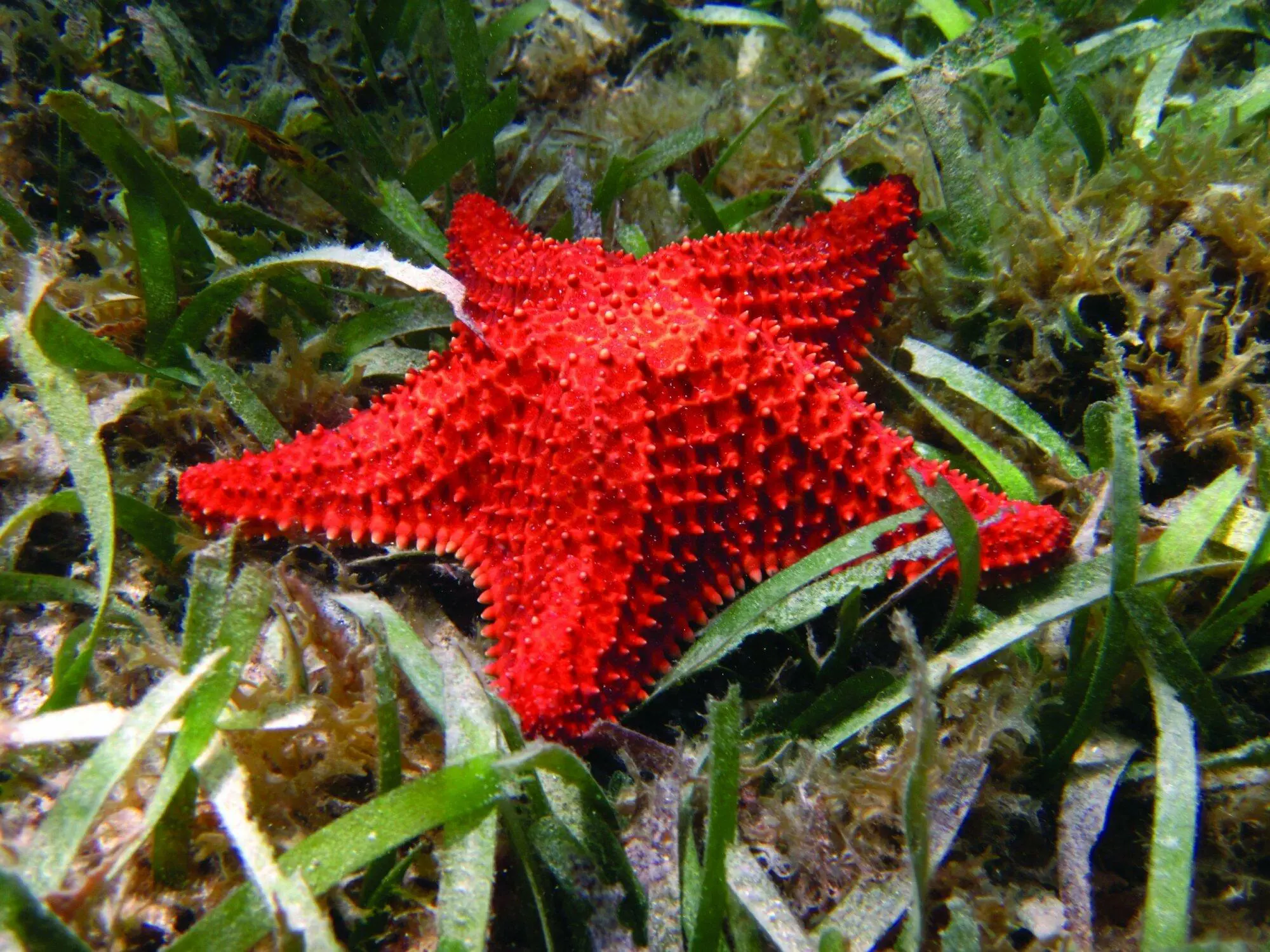
A seagrass meadow is an ecosystem made up of plants made up of plants that have readapted to marine life and thrive on sandy bottoms.
The starfish moves through the seagrass beds thanks to a system of water-filled canals that drive a multitude of small “ambulacary” feet.
The Linkia starfish is capable of reconstructing a complete starfish from a severed arm.
In Martinique’s seagrass beds, two species predominate: turtle grass and manatee grass.
The white sea urchin lives in seagrass beds and sometimes in shallow reefs. During the day, it often covers itself with pebbles and debris to conceal itself.
If stepped on, its spines tend to break off in the wound. Fortunately, it is not venomous and presents no great danger if the wound is properly cleaned with hot water or vinegar. Our bodies will dissolve the pieces of silica within a few weeks.
Despite increasingly drastic restrictions, sea urchins are becoming increasingly rare in Martinique, not least because of the consumption of this highly prized delicacy. Prices have risen sharply. The disappearance of the sea urchin has led to an overpopulation of algae that is detrimental to the coral, dangerously altering the ecosystem. Pleasure fishing is banned, but poaching continues.
Coral reefs are natural structures built by marine animals (corals, calcareous algae, etc.). They are the second most biologically rich ecosystem after tropical rainforests.
The black sea urchin lives in coral reefs, but when young prefers seagrass beds.
Its very long, toxic spines can measure up to 30 cm. It has the ability to direct them at anything it might take as a threat (your legs or hands, for example). So pay close attention to your position in the water to avoid brushing against them.
Sea urchin spines are articulated at their base and are used for both movement and defense.
Echinoderms have a skeleton made up of calcareous parts (plates or spicules) with systematically 5 symmetrical rays.
The reef urchin is the most resistant to swell, as it bores a hole in the rock to provide shelter during the day.
Ophiuroids have a central disk up to 2 cm in diameter and five arms adorned with rows of spines.
Its arms are very fragile, but can be regenerated. It moves with undulating movements of its arms.
Very voracious, it feeds at night on the remains of dead animals.
The comatula is one of the oldest echinoderms.
It looks like a plant, but it’s an animal. It has a body with a cup-shaped central part (the calyx) from which five arms extend, usually branching out into 10 arms.
The comatula attaches itself to a hollow in the reef or to a sponge by means of cirri on the underside of its calyx.
It feeds on suspended organic particles, which it captures and carries back to its mouth via a current system in the groove of its arms.
The holothurian has a cucumber-shaped body, which is why we also call it a sea cucumber.
The pentarad symmetry common to all echinoderms is not visible from the outside, but could be seen if you cut a slice of cucumber.
It moves slowly over sandy bottoms.
A detritivore, it feeds on organic waste by ingesting large quantities of sand, which it then ejects cleaned. It is therefore a sand cleaner. Small sand droppings can be seen along its path.
In Creole, it’s called “pipi lanmè” because, when crushed, the holothurian releases the water absorbed for breathing; or “coco lanmè” because, in the event of attack, some eject a filament composed of a sticky liquid (or even part of its organs) to trap the enemy.
A mollusk with a whitish shell measuring 2 to 3 cm.
It feeds on polyps, which is why it is found on gorgonians. In fact, it’s not uncommon to find several individuals on the same gorgonian!
Its skeleton was used as currency by indigenous populations from the 17th to the 19th century, hence the term “Caribbean currency” for this gastropod mollusc.
The lambi is a mollusk with a muscular foot.
It lives mainly in seagrass beds, feeding on the seabed by collecting plant debris and certain types of algae.
It is protected and fishing is regulated.
Catching restrictions: it must have a well-formed flag and at least 250 g of flesh. Boaters may not catch more than 3 lambis per day.
Very popular in the West Indies, it can be prepared as fricassee, blood sausage, etc. Its conch can be used as a musical instrument: in the past, Martinican fishermen used it to announce their departure and return from fishing. There is an authentic lambi dialect.
This invertebrate has eight arms and a brain, giving it a certain capacity for learning.
It can change the color and structure of its skin to camouflage itself.
Extremely flexible, it can fit into small holes.
It lives from 1 to 3 years and reproduces only once.
In Martinique, chatrou fricassee is a famous traditional dish.
Chat with us directly from WhatsApp